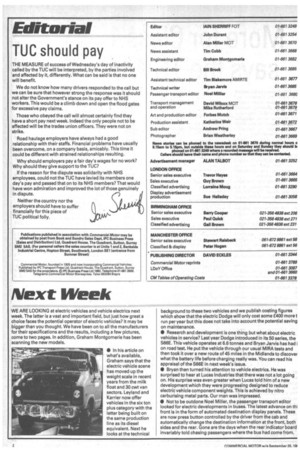Next Week
Page 2

If you've noticed an error in this article please click here to report it so we can fix it.
WE ARE LOOKING at electric vehicles and vehicle electrics next week. The latter is a vast and important field, but just how great a choice faces the potential operator of electric vehicles? It may be bigger than you thought. We have been on to all the manufacturers for their specifications and the results, including a few pictures, come to two pages. In addition, Graham Montgomerie has been scanning the new models.
• In his article on what's available, Graham says that the electric vehicle scene has moved up the weight scale in recent years from the Milk float and 30 cwt van sectors. Leyland and Karrier now offer vehicles in the six ton plus category with the latter being built on the same production line as its diesel equivalent. Next he looks at the technical background to these two vehicles and we publish costing figures which show that the electric Dodge will only cost some £400 more t run per year but this does not take into account the potential saving on maintenance.
• Research and development is one thing but what about electric vehicles in service? Last year Dodge introduced in its 50 series, the S66E. This vehicle operates at 6.6 tonnes and Bryan Jarvis has had i on road test. He put the vehicle through our usual MIRA tests and then took it over a new route of 45 miles in the Midlands to discover what the battery life before charging really was. You can read his appraisal of the S66E in next week's issue.
0 Bryan then turned his attention to vehicle electrics. He was surprised to hear at Lucas Industries that there was not a lot going on. His surprise was even greater when Lucas told him of a new development which they were progressing designed to reduce electric vehicle component weights. This is achieved by nitro carburising metal parts. Our man was impressed.
• Not to be outdone Noel Miller, the passenger transport editor looked for electric developments in buses. The latest advance on thi front is in the form of automated destination display panels. These are now press button controlled by the driver from the cab and automatically change the destination information at the front, both sides and the rear. Gone are the days when the rear indicator board invariably told chasing passengers where the bus had come from.












































